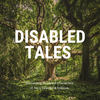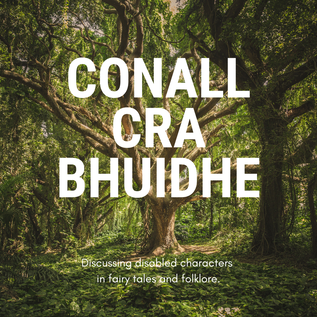|
Disability is common within European folktale canon. Charles Perrault’s literary tale, “Ricky the Tuft,” features a deformed protagonist (Betts, 2009). Hans Christian Andersen’s “The Little Mermaid” becomes mute and suffers chronic pain (Hersholt, 1949). The Brothers Grimm added disability to stories in which none were present (Schmiesing, 2014). Disability is also a component of lesser-known tales. Consider “Conall Cra Bhuidhe” (Campbell, 1890). The story is Aarne-Thompson-Uther type 953, “The Robber and His Sons” (Uther, 2004) and recounts a man’s efforts to save his sons from execution, initially by stealing a foreign king’s horse, then by telling the monarch thrilling anecdotes. The text notably avoids common and problematic tropes regarding disability. Three stereotypes are specifically absent. Firstly, the sexless and unpartnered disabled person (Kingsbury, 2022). Not only does Conall have four biological children and a wife, the latter admits she would rather lose their sons than lose him. Secondly, the disabled character being a villain (Leduc, 2020). While the story does feature a blind, cannibalistic giant as an antagonist, any association between disability and evil is negated by the fact that Conall is missing a finger, making him disabled too. Thirdly, disabilities are cured as part of happy endings (Maaren, 2019). Conall lost a digit at some point during early adulthood and remains disabled by the narrative’s end. It’s even implied that he doesn’t wear a prosthetic or do anything to hide his condition. Despite these positives, the narrative contains problematic tropes. It uses disability as a form of punishment (Kingsbury, 2022). This applies to Conall and the giant. The former is forced to sever his finger because he boasted to his enemy, then wore a magic ring his enemy gave him. The latter is blinded for trying to kill and eat the protagonist. At least the context provides justification; people are likelier to suffer permanent injury during battle than when attending their abused stepsister’s wedding, as occurs in the Grimm’s tale “Ashputtle” (Manheim, 1983). Additionally, disability is treated as superficial (Kingsbury, 2022). This is most evident with Conall, both in the main narrative and the third embedded one. Despite his missing finger, he’s never shown to struggle with fine motor activities like climbing or tying knots. This unusually nuanced quality may relate to the informant. According to Campbell’s notes, the tale was recited by James Wilson, a blind fiddler from Islay, whose blindness influenced his telling. Assuming this information is accurate, “Conall Cra Bhuidhe” is a milestone in the history of disability representation because it’s the story of a disabled protagonist by a disabled narrator. “Conall Cra Bhuidhe” has a lot to offer in terms of disability studies and general entertainment. People concerned with the former receive a glimpse into the treatment of disabled people in nineteenth-century Scotland and get to experience a disabled character as the protagonist. As for the latter, people will find a story that appeals to our desire to protect the ones we love. Few other narratives are so multifaceted. Bibliography Betts, Christopher. (2009). The complete fairy tales. Oxford University Press. Kingsbury, Margaret. (2022, Feb 21). 9 ableist tropes in fiction I could do without. Book Riot. Retrieved from http://web.archive.org/web/20220221122918/https://bookriot.com/ableist-tropes-in-fiction/ Campbell, John. F. (1890). Popular tales of the west highlands. Edinburgh: Edmonston & Douglas. Hersholt, Jean. (1949). The complete andersen. New York: The Limited Editions Club. Retrieved from https://andersen.sdu.dk/vaerk/hersholt/TheLittleMermaid_e.html Leduc, Amanda. (2020). Disfigured: On fairy tales, disability, and making space. Toronto: Coach House Books. Maaren, Kari. (2019). The blind prince reimagined: Disability in fairy tales. Uncanny Magazine. Retrieved from https://www.uncannymagazine.com/article/the-blind-prince-reimagined-disability-in-fairy-tales/ Manheim, Ralph. (1983). Grimms’ tales for young and old: The complete stories. Anchor Books. Schmiesing, Ann. (2014). Disability, deformity, disease in the grimms’ fairy tales. Detroit: Wayne State University Press. Uther, Hans-Jorg. (2004). The types of international folktales. A classification and bibliography. Based on the system of antti aarne and stith thompson. Part I. Animal tales, tales of magic, religious tales, and realistic tales, with an introduction. Helsinki: Suomalainen Tiedeakatemia.
0 Comments
|
Disabled TalesDiscussing disabled characters in fairy tales and folklore! Categories
All
Archives
June 2023
|


